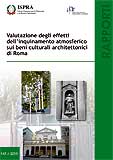The effects of atmospheric pollution on cultural property in Rome

The atmospheric pollution and the weather conditions synergically contribute to accelerate the natural deterioration phenomena of materials constituting cultural property.
The different damage typologies, that can be found on cultural objects, depend on materials composition of monuments and on climatic, environmental and topographic characteristics of the surrounding territory.In this report the erosion process regarding carbonate stone in Rome was analyzed.In particular, the annual surface recession of limestone due to rainfall and atmospheric pollution was calculated using the dose-response function developed within European Multiassess project (Model for multi-pollutant impact and assessment of threshold levels for cultural heritage). The damage was estimated using meteorological parameters (rainfall and relative humidity) and atmospheric pollutant concentrations (nitrogen oxides, sulphur oxides and airborne particulate matter) measured by the air quality monitoring stations in Rome in 2009.
Moreover the annual average concentrations of air pollutants were used to produce pollution mapping by geostatistical interpolation techniques. The distribution maps of pollutants allowed to assess the mass loss in the area circumscribed by air quality monitoring stations (within the GRA, Great Ring Road).
The erosion data were correlated to conservative condition information of 77 architectural monuments in Rome to estimate their potential deterioration risk.
The methodology described in this work allowed to individuate the most aggressive areas for monuments in Rome and their potential risk level; this information can be considered a support to the planning of maintenance and monitoring actions.
Publication available only on-line
Download the publication (pdf- 2.4 mb)
